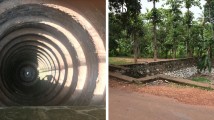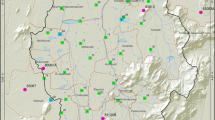Abstract
Groundwater potential (GWP) of an aquifer refers to availability of extractable groundwater resources. GWP of aquifers is commonly estimated in terms of aquifer yield (Y), normalised yield (YN), specific capacity (Sp-C) and productivity (PA). These aquifer parameters have certain advantages and limitations in assessing GWP. Significance of using these parameters as estimators is lying with their ability to change the rank and status of GWP of different aquifers when compared. Therefore, use of different estimators may lead to contradictory status of GWP. To examine this, in this study, GWP of aquifers has been evaluated using the aforesaid aquifer parameters, and compared. Applicability and suitability of these parameters have been examined and discussed in this article with the help of hypothetical examples and through a case study from the composite crystalline aquifers of the Aravalli Terrain, India. Through logical deduction, the study infers that productivity is a superior measure for GWP as it provides a comparison of groundwater resources among aquifers not only on the basis of rate of water discharge but also in terms of sustainability of groundwater resource.




Similar content being viewed by others
Abbreviations
- d :
-
depth of well
- d S :
-
saturated well section
- P A :
-
aquifer productivity
- P W :
-
well productivity
- S :
-
storativity
- Sp-C:
-
specific capacity
- s w :
-
drawdown after pumping
- T :
-
transmissivity
- T S :
-
saturated thickness
- Y :
-
yield
- Y N :
-
normalised yield
References
Banks D, Morland G, Frengstad B (2005) Use of non-parametric statistics as a tool for the hydraulic and hydrogeochemical characterization of hard rock aquifers. SCOTTISH J GEOL 41(1):69–79
Bhuiyan C (2010) Hydrogeological factors: their association and relationship with seasonal water-table fluctuation in the composite hardrock Aravalli terrain, India. ENVIRON EARTH SC 60:733–748
Bhuiyan C, Singh RP, Kogan FN (2006) Monitoring drought dynamics in the Aravalli terrain (India) using different indices based on ground and remote sensing data. Int J Appl Earth Obs Geoinf 8:289–303. https://doi.org/10.1016/j.jag.2006.03.002
Bhuiyan C, Flügel WA, Singh RP (2009a). Erratic monsoon, growing water demand, and declining water table. J SPATIAL HYDROL 9(1), Spring 2009
Bhuiyan C, Singh RP, Fügel WA (2009b) Modelling of ground water recharge-potential in the hard-rock Aravalli terrain. India: a GIS approach ENVIRON EARTH SC 59:929–938. https://doi.org/10.1007/s12665-009-0087-4
Carlsson L, Carlstedt A (1977) Estimation of transmissivity and permeability in Swedish bedrock. Nord Hydrol 8:103–116
Clark L (1977) The analysis and planning of step drawdown tests. GEOL SOC EN 10:125–143
Cohen AJB, Karasaki K, Benson S, Bodvarsson G, Freifeld B, Benito P, Cook P, Clyde J, Grossenbacher K, Peterson J, Solbau R, Thapa B, Vasco D, Zawislanski P (1996) Hydrogeologic characterization of fractured rock formations: a guide for groundwater remediations. U.S. Environmental Protection Agency, National Risk Management, Research Laboratory, Cincinnati, Ohio 45268, Research and Development EPA/600/S-96/001
Daniel CC (1989) Statistical analysis relating well yield to construction practices and siting of wells in the Piedmont and Blue Ridge provinces of North Carolina. USGS WATER-SUPPLY PAPER 2341-A
Davis SN, Turk LJ (1964) Optimum depth of wells in crystalline rocks. Ground Water 2(2):6–11
Department of Science, Technology (DST) (1994) Resource atlas of Rajasthan. Government of Rajasthan, Jaipur
El-kadi AI, Oloufa AA, Eltahan AA, Malik HU (1994) Use of a geographic information system in site-specific ground water modelling. Ground Water 32:617–625
Freeze RA, Cherry JA (1979) Groundwater. Prentice Hall Inc. New Jersey, Englewood Cliffs
Fshae OA, Tijani MN, Talabi AO, Adedeji OI (2014) Delineation of groundwater potential zones in the crystalline basement terrain of SW-Nigeria: an integrated GIS and remote sensing approach. Appl Water Sci 4:19–38
Graham MT, Ball DF, Dochartaigh O, MacDonald AM (2009) Using transmissivity, specific capacity and borehole yield data to assess the productivity of Scottish aquifers. Quarterly Journal of Engineering GEOL AND HYDROGEOL 42:227–235
Groundwater Department (GWD) (2000). Annual report. Government of Rajasthan, India
Henriksen H (1995) Relation between topography and well yield in boreholes in crystalline rocks, Sogn og Fjordane, Norway. Ground Water 33(4):635–643
Henriksen H (2003) The role of some regional factors in the assessment of well yields from hard-rock aquifers of Fennoscandia. Hydrogeol J 11(6):628–645
Jetel J (1968) A new comparative regional parameter of permeability for hydrogeologic maps. In: Mémoires of the 8th Congress of International Association of Hydrogeologists, Istanbul 1967, VIII, 101-107
Kim JC, Jung HS, Lee S (2019) Spatial mapping of the groundwater potential of the Geum River Basin using ensemble models based on remote sensing images. Remote Sens 2019(11):2285. https://doi.org/10.3390/rs11192285
Knopman DS, Hollyday EF (1993) Variation in specific capacity in fractured rocks, Pennsylvania. Ground Water 31(1):135–145
Krishnamurthy J, Venkatesa Kumar N, Jayaraman V, Manivel M (1996) An approach to demarcate ground water potential zones through remote sensing and a geographic information system. Int J Remote Sens 17:1867–1884
Lattman LH, Parizek RR (1964) Relationship between fracture traces and the occurrence of ground water in carbonate rocks. J Hydrol 2:73–91
Loiselle M, Evans D (1999) Fracture permeability and density distributions in coastal Maine. In: The Proceedings of the Focus Conference on Eastern Regional Groundwater Issues, J Lehr (ed.), 255–271, Dublin, Ohio: National Ground Water Association
Mace RE (1997) Determination of transmissivity from specific capacity tests in a karst aquifer. Ground Water 35(5):738–742
Mace, R.E., 2000. Estimating transmissivity using specific-capacity data. Bureau of Economic Geology, The University of Texas at Austin. http://www.twdb.state.tx.us/Gam/GAM_documents/sc_report.pdf
Mace RE (2001) Estimating transmissivity using specific-capacity data. Bureau of Economic Geology, The University of Texas at Austin; Austin, Texas. GEOLOGICAL CIRCULAR 01–2
Moore RB, Schwarz GE, Clark SE Jr, Walsh GJ, Degnan JR (2002) Factors related to well yield in the fractured-bedrock aquifer of New Hampshire. U. S. GEOLOGICAL SURVEY PROFESSIONAL PAPER 1660
Morland, G. (1997) Petrology, lithology, bedrock structures, glaciation and sea level. Important factors for groundwater yield and composition of bedrock boreholes? NGU rapport 1997.122 vol 2, pp 401
Naik PK, Awasthi AK, Anand AVSS, Mohan PC (2001) Hydrogeologic framework of the Deccan terrain of the Koyna River basin, India. Hydrogeol J 9(3):243–264
Olofsson B (1994) Flow of groundwater from soil to crystalline rock. APPL HYDRGEOL 2(3):71–83
Pinto D, Shrestha S, Babel MS, Ninsawat S (2017) Delineation of groundwater potential zones in the Comoro watershed, Timor Leste using GIS, remote sensing and analytic hierarchy process (AHP) technique. Appl Water Sci 7:503–519. https://doi.org/10.1007/s13201-015-0270-6
Prasad RK, Mondal NC, Banerjee P, Nandakumar MV, Singh VS (2008) Deciphering potential groundwater zone in hard rock through the application of GIS. Environ Geol 55:467–475
Randolph RB, Krause RE, Maslia ML (1985) Comparison of aquifer characteristics derived from local and regional aquifer tests. Ground Water 23(3):309–316
Rayne TW, Bradbury KR, Muldoon MA (2001) Delineation of capture zones for municipal wells in fractured dolomite, Sturgeon Bay, Wisconsin, USA. Hydrogeol J 9(5):432–450
Sander P, Chesley MM, Minor TB (1996) Groundwater assessment using remote sensing and GIS in a rural groundwater project in Ghana: lessons learned. Hydrogeol J 4:40–49
Saraf AK, Choudhury PR (1998) Integrated remote sensing and GIS for ground water exploration and identification of artificial recharge sites. Int J Remote Sens 19:1825–1841
Shahid S, Nath SK, Roy J (2000) Ground water potential modelling in a soft rock area using a GIS. Int J Remote Sens 21:1919–1924
Siddiqui SH, Parizek RR (1971) Hydrogeological factors influencing well yields in folded and faulted carbonate rocks in central Pennsylvania. Water Resour Res 7(5):1295–1312
Singhal BBS, Gupta RP (2010) Applied hydrogeology of fractured rocks, 2nd edn. Springer, Heidelberg
Summers WK (1972) Specific capacities of wells in crystalline rocks. Ground Water 10(6):37–47
Theis CV, Brown RH, Meyer RR (1983) Estimating the transmissibility of aquifers from the specific capacity of wells. In Bentall R (comp.) Methods of determining permeability, transmissibility, and drawdown. USGS Water-Suppl Pap 1536-1, 331–341
Uma KO, Kehinde MO (1994) Potentials of regolith aquifers in relation to water supplies to rural communities: a case study from parts of Northern Nigeria. J Min Geol 30(1):97–109
Viswanathiah MN, Sastri JVC (1978) Specific capacity of wells in some hard rocks of Karnataka. J Geol Soc India 19(9):426–430
Wladis D, Gustafson G (1999) Regional characterization of hydraulic properties of rock using air-lift data. Hydrogeol J 7(2):168–179
Yin ZY, Brook GA (1992) The topographic approach to locating high-yield wells in crystal-line rocks: does it work? Ground Water 30(1):96–102
Zabihi M, Pourghasemi HR, Pourtaghi ZS, Behzadfar M (2016) GIS based multivariate adaptive regression spline and random forest models for groundwater potential mapping in Iran. Environ Earth Sci 75:665. https://doi.org/10.1007/s12665-016-5424-9
Acknowledgements
The author is expressing his sincere thanks to Dr. S.M. Pandey (ex-chief geophysicist) and Dr. U.K. Singh (ex-geophysicist) of Ground Water Department, Jodhpur, and to Mr. Anurag Khanna (ex-geologist) Central Ground Water Board, Jaipur for extending help in the procurement of geological and hydrological data of the study area.
Author information
Authors and Affiliations
Corresponding author
Additional information
Responsible Editor: Broder J. Merkel
Rights and permissions
About this article
Cite this article
Bhuiyan, C. Application of different aquifer parameters for groundwater potential evaluation—implications for resources development. Arab J Geosci 13, 752 (2020). https://doi.org/10.1007/s12517-020-05678-z
Received:
Accepted:
Published:
DOI: https://doi.org/10.1007/s12517-020-05678-z




